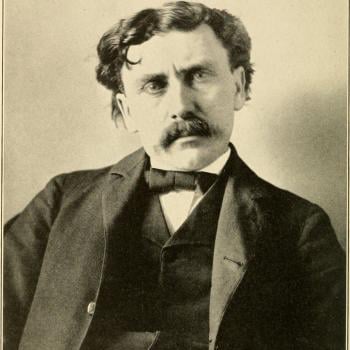I have been describing the Japanese campaign against Christianity, which peaked in the early seventeenth century. That story has a bizarre and quite moving aftermath.
Notionally, the Christian church was utterly destroyed by about 1650, and the authorities sought out possible underground believers by making them defile the cross. Yet their success was not as total as they believed.
Japanese isolation ended in 1853, when a US warship forced the nation to open to external trade and contact. Christian missionaries were among the other Europeans who arrived over the following years, and in 1865, a Catholic priest named Bernard Pettijean received some surprising visitors. Nervously, and in constant fear of detection, fifteen elderly Japanese peasants wanted to ask him what he knew about the faith they had maintained secretly over the past two centuries. They asked particularly about:
O Deusu Sama, O Yasu Sama, and Santa Maria Sama, by which names they designated God, Jesus Christ and the Blessed Virgin. The view of the statue of the Madonna and Child recalled Christmas to them… they asked me if we were not in the seventeenth day of the Time of Sadness (Lent); nor was St. Joseph unknown to them.
In remote fishing villages and island communities like Narushima, these Kakure Kirishitan, “hidden Christians”, had somehow maintained their clandestine traditions, together with other shreds of faith. One moving documentary from the 1990s, Otaiya, actually allows us to hear very old believers reciting Catholic prayers that first came to the region over four hundred years ago, some in Church Latin and sixteenth century Portuguese. They pray “Ame Maria karassa binno domisu terikobintsu,” a recollection of “Ave Maria gratia plena, dominus tecum, benedicta….” And they lovingly display a fragment of a silk robe once worn by one of the martyred Fathers. The film shows us the two last members of the indigenous hereditary priesthood, both frail men in their nineties, but the distant successors of Francis Xavier.
The story is awe-inspiring, but we have to put it in context. Not surprisingly, the total separation from an organized church meant that this catacomb church strayed far from mainstream Catholicism, and many of its practices make it look almost like a Shinto sect: their Eucharistic elements are rice, fish and sake. They knew nothing of the wider church, believing themselves to the world’s only true Christians. Also, the numbers involved were tiny, perhaps in the low ten thousands by 1865, and even those faced a renewed persecution once their presence became known.
More recently, the hidden Christian community, a pathetic remnant of the communities of the seventeenth century, has shrunk almost to nothing as a result of Japan’s demographic stagnation.
For practical purposes, Japan eliminated its Christians quite as thoroughly as medieval Europe destroyed its Albigensians, and the limited development of Christianity in modern Japan belongs entirely to the period after the 1850s.
BTW, a good recent book on the subject is John Dougill, In Search of Japan’s Hidden Christians: A Story of Suppression, Secrecy and Survival (Tokyo: Tuttle 2012)












